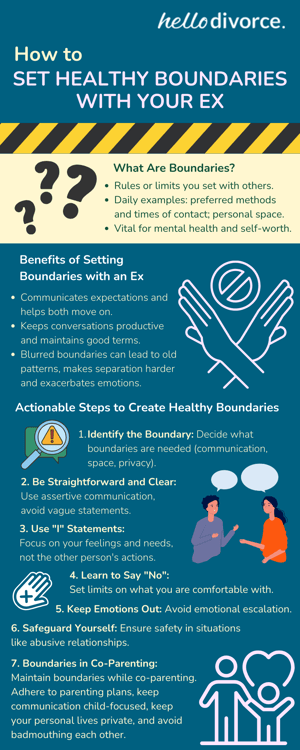How to Set New Boundaries with Your Ex

- What are boundaries, and why are they important?
- Why set boundaries with your ex?
- Step-by-step guide: Boundary plan post-breakup
- Examples of boundary-setting with ex-partners
- Navigating your changing boundaries
- Tips for maintaining healthy boundaries with your ex
- What happens if my ex violates a boundary?
- Keeping personal boundaries while co-parenting
Going through any form of separation or break-up is tough for anyone involved. However, it’s even harder to navigate your future when your ex is pressing your buttons and continuing to interfere with your life.
This is where boundaries come in. They help you and your ex learn how to navigate your new relationship after separation.
What are boundaries, and why are they important?
Boundaries are rules or limits you set with other people or yourself. These imaginary lines help you keep your relationships with others – including ex-partners – respectful, caring, and supportive.
Whether you realize it or not, you likely set boundaries with people on a daily basis. When you tell your boss you’re unavailable after working hours or politely decline a last-minute dinner invitation, you’re setting boundaries. When you ask noisy neighbors to turn their music down, you’re setting a boundary.
No matter how small these gestures seem, boundaries are important for your mental health and physical well-being. They help you avoid stress and burnout and inform others of your limits. They also help you avoid becoming a “doormat” and letting others take advantage of you, which is vital to your sense of self-worth.
Without healthy boundaries, emotions like anger and resentment can set in. Over time, these feelings can lead to unhealthy communication and damaged relationships.
Why set boundaries with your ex?
When you decide to end a romantic relationship with someone, boundaries are especially important. Setting firm boundaries communicates your expectations for the future with your former partner. It helps you both move on in a healthy way. Boundaries can also help you stay on good terms and keep your conversations productive during and after divorce.
Without clear boundaries, you and your ex may fall into old patterns of behavior. This makes the separation more difficult, which only exacerbates the heartache and grief you’re probably already feeling. Many separated couples find it difficult to truly move on until these boundaries are in place.
Step-by-step guide: Boundary plan post-breakup
Here's a general step-by-step plan to help you create and stick to boundaries post-breakup or divorce:
1. Reflect on your emotional needs
Set aside some quiet time to get a clearer understanding of your feelings, needs, and priorities going forward, from yourself and from a future partner. Reflect on your past experiences and identify any patterns or behaviors that you want to avoid. Try to parse lessons from your mistakes.
2. Identify your must-haves
Determine what boundaries are necessary for your emotional, mental, and physical health. Consider boundaries related to communication, space, time, and interactions with your ex-partner or others involved. We’ve listed specific examples below.
3. Communicate clearly
Express your boundaries directly and clearly to your ex (if necessary). Use "I" statements to convey your needs without blaming or criticizing. Be assertive, clear, and concise. You may also want to be open to negotiating boundaries if your ex asks.
4. Set physical boundaries
Establish physical boundaries such as moving out, designating who has access to shared spaces if still living or working together, and dividing your stuff.
5. Define your emotional boundaries
Determine topics or behaviors that are off-limits or need to change, and communicate them clearly or put them into action. Decide when and how often you will communicate or interact with your ex.
6. Focus on yourself
Allocate time for self-care, hobbies, and activities that bring you joy and fulfillment.
7. Enforce boundaries consistently
This is one of the hardest parts. Saying what boundaries you want is only part of it – you must stick to them. Be consistent. Practice what you expect from your ex. Calmly explain how a boundary was violated if/when it happens.
8. Seek support
Lean on trusted friends, family, or see a therapist for support and guidance as you navigate your boundaries.
9. Review and adjust
Some boundaries can fall away or change over time. Regularly assess your boundaries to ensure they are still serving your best interests.
Examples of boundary-setting with ex-partners
Not sure what specific types of boundaries to set? They range from physical to digital and emotional. Here are some examples of boundary-setting you might decide to use with your ex:
Physical boundaries
- Arrange a schedule for picking up/dropping off kids – no unexpected visits.
- No touching or other physical contact.
- Set aside specific days/times for any necessary in-person interaction, such as co-parenting or financial meetings.
- Block out time that’s dedicated to your work/health/hobbies and ask not to be contacted during these times, unless in an emergency.
- Set rules for both of your time with mutual friends or family. You might say: "I'm okay with you staying friends with Amy, but I'd appreciate it if you avoid discussing our matters with her."
- Once your shared finances are settled, do not lend each other money or purchase things together.
Communication boundaries
- Tell your ex your preferred method of communication (such as text or email vs. phone calls).
- Say: "I need some space right now. Let's take a break from all communication for a week."
Social media boundaries:
- Unfollow/unfriend your ex.
- Avoid posting about each other.
- Filter what your ex can see (start posting to “Close Friends” or select groups only; omit your ex).
- Stay off social media if you find it upsetting.
Emotional boundaries:
- Tell your ex that you cannot provide them emotional support for now/anymore.
- Say: "Let's stop talking about our past or blaming each other. Both of us need to move forward."
- Avoid triggers, such as looking at old photos of your ex and places you went together.
- Set aside only a few minutes a day to reflect on things like “what ifs” if you can’t stop ruminating on the past entirely.
These examples are starting points. You can set any that suit your needs as you move forward from your break-up.
Navigating your changing boundaries
Just like every other aspect of our lives, the boundaries we set with others change over time. For example, as we grow more comfortable around certain people, we might let our guard down and loosen the boundaries we previously set with them. Similarly, when we experience a break-up or divorce, the boundaries we previously established with a partner change in the other direction.
Change is difficult for everyone, especially in situations like separation and divorce. But no matter how uncomfortable these changes are for you and your former partner, it’s important to remain firm on any new boundaries you set – and to respect boundaries set by your ex-partner as well.
Communication is key
These “growing pains” in your new relationship with your ex can be easier to manage with clear, concise communication. You may both need reminders about what is and is not appropriate as you move on. As long as you both agree to actively listen to each other and communicate with respect, you can handle these changes in a mature way.
If you see your former partner struggling with changing boundaries, try to remain calm and consistent. Restate your boundaries as often as required, even if you sound like a broken record. Eventually, your calmness and consistency will help them understand the new boundaries of your relationship.
If you’re the one having a hard time with the changes in your relationship, remember what is in your control and what isn’t. You can also rely on your support system when you need to vent or cope with your emotions.
Tips for maintaining healthy boundaries with your ex
Setting boundaries with anyone can be hard, but doing so with a former partner can be incredibly difficult. Here are some actionable steps to create healthy boundaries with an ex.
Identify and set long-term boundaries
Think about what boundaries you will need in the long term to help you live your life and possibly form new healthy relationships. This may involve setting boundaries regarding mutual friends or social media. Although these boundaries can change over time, it's worth considering everything you can in the beginning because it's far easier to adjust boundaries as you grow more comfortable than to inflict harsh boundaries when you realize you’ve been too lax.
Eventually, one or both of you will start dating and meet new partners (perhaps one of you already has). You may need to change or relax some boundaries. Maybe you will need to set new boundaries with the new person in your ex’s life, especially if you share children.
Be straightforward and clear
Regarding boundaries, we can’t minimize the importance of using concise, assertive communication. Cryptic or vague statements set the stage for misunderstandings and arguments. So, even if it feels harsh, it's best to be straightforward.
Don't apologize or imply that your boundaries are an imposition. They’re not. To do so would be to undermine yourself and set the premise that your needs and desires aren't important. It would also leave room for your ex to push the limits or ignore your demands.
Use “I” statements,” not “you” statements
It’s all too easy to place blame on your former spouse during divorce, but this approach puts the other person on the defensive and turns boundary-setting into accusations and arguments. Instead, approach this process from the perspective of yourself, not the other person.
“I” statements are a form of assertive communication that focuses on the speaker’s feelings, beliefs, and needs rather than the listener’s behaviors or thoughts. Instead of saying, “You need to stop text messaging me,” you might say, “I need some space. Could we pause text message communication?” This helps focus the conversation on the person speaking, which avoids defensiveness and arguments.
Learn to say “no”
Although setting boundaries is about telling other people what you need, it sometimes involves placing limits on what you will do for them. This means you must say “no” if you aren’t comfortable with the demands a former romantic partner places on you. For example, you can say no to phone calls or spending time together, and you can choose not to respond if your ex pries into your personal life.
Keep emotions out of it as much as possible
When emotions run high, it’s easy for simple conversations to escalate into disagreements. But no rule says you must express emotions when setting boundaries – so don’t. You may find that your ex is more responsive when emotions are removed.
For example, let’s say you run into your ex at a party hosted by mutual friends. During the conversation, they keep trying to touch you in some way. You might want to scream, “Stop touching me!” but doing so would only make the situation worse. So, instead, you might say, “It’s nice to see you, but I don’t feel comfortable with you touching me. If we can’t just stand and talk, then I’d like to leave.”
There are some situations, such as abusive relationships, where setting boundaries yourself is neither safe nor beneficial. In these instances, it’s better to simply remove yourself from the other person as much as possible and take advantage of the legal system for the rest. You will want to make sure you’ve got measures in place that keep you safe, even if you aren’t directly interacting with your ex. We have more guidance on this below.
What happens if my ex violates a boundary?
If your ex fails or refuses to respect your boundaries despite all your efforts, here are steps you can take:
- Reiterate your boundaries: Remind your ex of the boundaries you've set calmly and firmly. Use "I" statements to express how their behavior impacts you.
- Set consequences: Communicate the consequences if they continue to step on the said boundary. For example, you may limit or cut off communication, seek legal action, or hire a mediator.
- Seek support from experts: Meet with someone with experience in the area of the boundary your ex isn’t respecting, such as a family counselor for child custody issues or a lawyer for serious matters. Discuss your options and develop a plan to address the situation effectively.
- Document incidents: Keep a record of any instances where your ex disregarded your boundaries. This documentation can be helpful if you need to take further action.
- Consider legal options: If the situation escalates or becomes unsafe, get legal advice to explore your options, such as obtaining a restraining order or modifying custody arrangements.
- Stand firm: Remain consistent in enforcing your boundaries and following through with consequences if needed. Consistency can help reinforce the importance of respecting your boundaries.
Remember that you have the right to set and maintain boundaries that protect yourself and your children. If your ex-partner continues to disregard your boundaries despite your efforts to address the issue, it may be necessary to take more decisive action to ensure your safety and peace of mind.
What to do if your health or safety are at risk because of a high-conflict or abusive ex
Here are some resources for support if setting boundaries with an ex is extremely challenging or impossible.
- National Domestic Violence Hotline: Get confidential support, crisis intervention, safety planning, and resources. They are available 24/7 via phone (1-800-799-7233) or visit their website at thehotline.org.
- National Coalition Against Domestic Violence: NCADV offers resources, advocacy, and support for survivors of domestic violence. Their website (ncadv.org) provides information on safety planning, legal resources, and finding local assistance.
- RAINN (Rape, Abuse & Incest National Network): RAINN is the largest anti-sexual violence organization in the United States, providing support, information, and resources for survivors of sexual assault and abuse. You can contact their 24/7 hotline at 1-800-656-4673 or visit rainn.org.
- Local shelters and organizations: Many communities have local shelters and organizations that provide support, counseling, shelter, legal advocacy, and resources for survivors of domestic violence. Search online or contact your local law enforcement or social services to find resources near you.
- Mental health services: Consider seeking therapy or counseling from a licensed mental health professional. They can provide emotional support, trauma care, and help you develop coping strategies and safety plans.
- Legal aid and advocacy organizations: There are organizations that offer free or low-cost legal aid and advocacy services. Contact your local legal aid society or domestic violence advocacy organization for guidance.
- Safety planning: The National Domestic Violence Hotline and other organizations can help you develop a personalized safety plan based on your specific situation.
- Financial assistance: If you're facing financial challenges due to the abuse or separation from your ex-partner, explore resources for financial assistance, housing support, and economic empowerment programs for survivors.
Keeping personal boundaries while co parenting
Many couples set tight boundaries or even go no-contact for a clean break with their ex after a divorce. However, most co-parenting couples have to continue their relationship to some degree in order to raise their children together. If your ex is still part of your life for this reason, boundaries are critical.
Healthy co-parenting boundaries include the following:
- Adhering to the parenting plan and custody schedule
- Keeping all communication strictly on the topic of your child
- Staying out of each other’s personal lives
- Agreeing not to badmouth each other in front of the kids
- Agreeing how to handle attendance at children's events or sharing information about their lives.
Remember: You deserve to have your needs met, and you have the right to set boundaries with your ex to gain closure, heal, and move on with your life.
.png)



